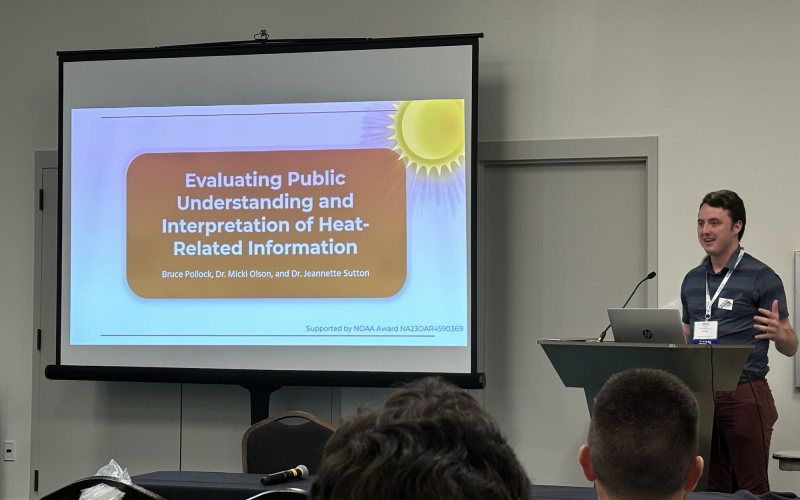CEHC Grad Student Presents on Extreme Heat at National Weather Communication Conference

By Mike Nolan
ALBANY, N.Y. (June 18, 2024) — University at Albany graduate student Bruce Pollock is passionate about improving risk communication around extreme weather events — a topic he spoke about last week to a national audience.
Pollock, a second-year master’s student in the College of Emergency Preparedness, Homeland Security and Cybersecurity’s (CEHC) Emergency Management and Homeland Security program, was awarded a scholarship to attend and present at the 51st Conference on Broadcast Meteorology/Seventh Conference on Weather Warnings and Communication from June 12-14 in Myrtle Beach, S.C.
The annual conference is hosted by the American Meteorological Society and focuses on the intersection of broadcast meteorology and communication.
“I am interested in the growing intersection of communication and meteorology, and this conference tied in perfectly with that,” Pollock said. “The scholarship covered all expenses related to the conference. It was a rare opportunity as a graduate student. I am eternally grateful for it.”
On campus, Pollock is a graduate research assistant on a project led by associate professor Jeannette Sutton and senior researcher Micki Olson of CEHC's Emergency and Risk Communication Message Testing Laboratory. The project, in partnership with the National Weather Service, aims to better understand how emergency information around extreme heat events is accessed and understood by people in the U.S.
From 2004–2018, an average of 702 heat-related deaths occurred in the United States annually, according to the Centers for Disease Control and Prevention. That’s more than the average from hurricanes and tornadoes combined.
So far, the research team has conducted 16 focus groups, allowing them to gather data and compare how people think about extreme heat in different parts of the country. Pollock shared results at the conference, along with more general insight into how the public understands and interprets heat warnings and advisories.
“Heat-related communication is seldom studied,” Pollock said. “This research is critical as climate change increases the duration and intensity of heat waves worldwide. Presenting our findings to a larger audience and interacting with meteorologists as a student was a big deal.”
“This conference was an exceptional opportunity for Bruce,” Olson added. “Presenting at conferences like this one helps students develop crucial skills, such as clearly communicating research findings to diverse audiences. Successful presentations also enhance students' visibility in their field, which can foster personal and professional growth. Overall, this is a significant platform for advancing both Bruce’s academic and career prospects.”
Now back at UAlbany, Pollock is conducting research alongside his lab mentors for the rest of the summer and thinking about what’s next after graduation.
“After graduation, I would like to continue to do research. But, I am still figuring out which avenue to take with that plan,” Pollock said. “Luckily, I have amazing mentors to guide me through this journey. I’m thankful to CEHC for providing me with the knowledge, skills and opportunities to grow as a professional.”
Interested in reading more about extreme heat? Olson recently published an article in The Conversation that explains heat index warnings and offers tips to protect yourself on dangerously hot days.




